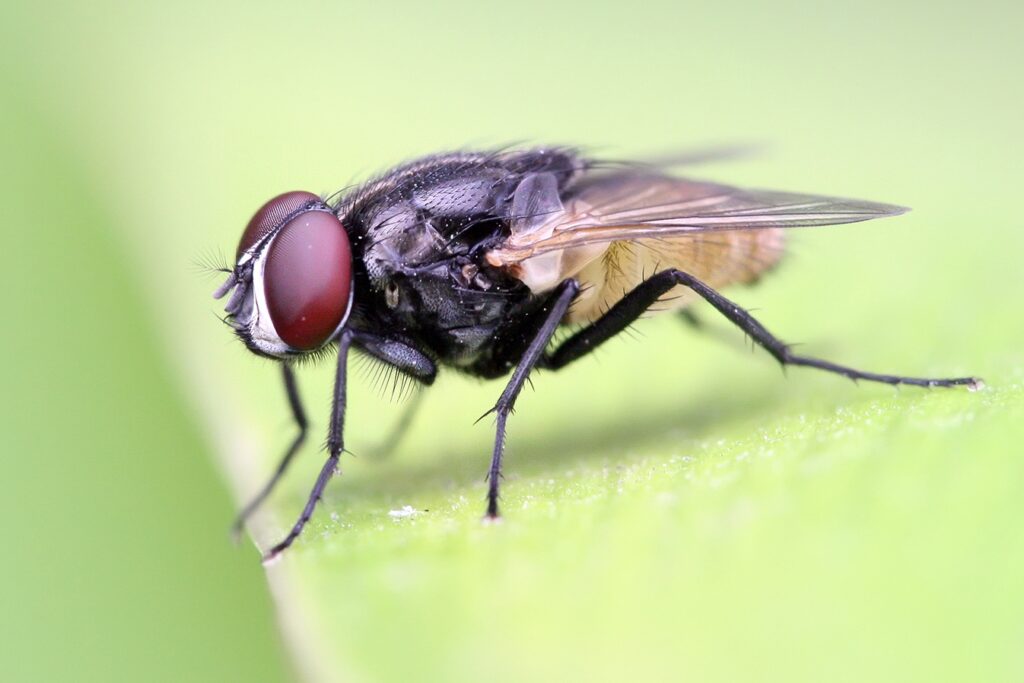Common Housefly (Musca domestica)

The common housefly, or Musca domestica, is one of the most widespread flies in human homes. It remains prevalent in the U.S., even when other species temporarily dominate.
Identification and Life Cycle
Houseflies are about one-third of an inch long. They have four dark stripes on their thorax and a uniquely curved fourth wing vein. Female houseflies lay eggs in batches of 75 to 150 on organic materials, which serve as food for the larvae (maggots) when they hatch. Common breeding materials include decaying food, garbage, and animal waste. In homes, garbage and dog manure are primary food sources for larvae. In food handling areas, spilled food and unwashed trash are more common.
Housefly eggs hatch into cream-colored larvae in about 24 hours. The larvae burrow into their food source, feeding and growing for three days to three weeks, depending on environmental conditions. They undergo several molts, shedding their exoskeletons as they progress through instar stages. Larvae are usually hidden within their breeding materials.
Once fully developed, larvae migrate to pupate away from their original sites. They may travel several feet to hundreds of yards. As they transition to the pupal stage, they form a darkening case that encases the developing fly.
Metamorphosis
Inside the pupal case, metamorphosis occurs, turning the maggot into an adult fly. This transformation takes a minimum of three days and may extend to three weeks. Once fully formed, the adult fly uses an “expander organ” near its head to escape from the pupal case.
In warm conditions, the pupal stage can last only four to six days, and under optimal circumstances, the entire life cycle from egg to adult may be completed in as little as eight days. This rapid reproduction allows for 10 to 12 generations in a single summer, illustrating the housefly’s significant breeding potential.
Feeding Habits and Health Risks
Adult houseflies have specialized mouthparts that allow them to feed on liquid substances. They consume food by regurgitating onto dry surfaces to dissolve solids before sucking up the resulting liquid. This feeding behavior can lead to the transmission of diseases, as houseflies often land on decaying matter or excrement before contaminating human food.
Common houseflies possess compound eyes, with male flies having eyes set closer together than females. They breathe through spiracles on their thorax and abdomen, with thoracic spiracles surrounded by hair that filters airborne particles.
Flight Range
Research indicates that houseflies generally do not stray far from their breeding sites. Studies involving tagged flies have shown that most remain within a city block or two of their origin, although some may travel as far as 25 miles under certain conditions.
Control of House Flies
Effective control of house flies requires an integrated approach that combines sanitation, traps, and insecticides. Maintaining cleanliness by removing potential breeding sites, such as decaying organic matter and unwashed trash, is essential in reducing their populations. Implementing traps can help monitor and control their numbers, while insecticides may be necessary in severe infestations. In addition, biological control methods involving natural predators can offer alternative strategies to chemical treatments.
Understanding the life cycle and habits of the common housefly is crucial for effective pest management. Learn more about our effective Fly Management services
FAQs About House Flies
- How fast do house flies reproduce? House flies can complete their life cycle in as little as eight days under optimal conditions, producing multiple generations in a single summer.
- What do house flies eat? House flies primarily feed on liquid substances, which they obtain by regurgitating onto solid food. They are attracted to a variety of organic materials, including food waste, excrement, and decaying matter.
- How far do house flies travel from their breeding sites? Research indicates that house flies typically do not travel more than one city block from their breeding sites, although some may be found up to 25 miles away under certain conditions.
- What are the health risks associated with the common housefly? House flies can transmit various pathogens through their feeding and breeding habits, contaminating food and surfaces with bacteria and viruses that can cause diseases like dysentery and gastrointestinal infections.
- What methods can I use to prevent house flies? To prevent house flies, maintain proper sanitation by disposing of waste, cleaning up spills promptly, and using traps or insecticides as needed. It’s also beneficial to seal entry points and ensure that food is stored properly.
